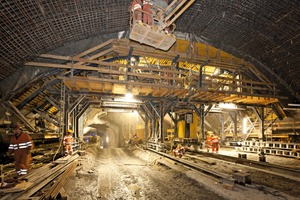Formwork Vibrator Application in the Mountains – Linthal PS Station
In Switzerland since 2009 the Kraftwerk Limmern JV has been involved in setting up a new pumped storage (PS) power station within the scope of the “Linthal 2015” construction project in the mountains. It will increase the power output of the already existing Linth-Limmern power plants (KLL) from their present 450 MW several times to reach some 1,450 MW in 2015. For comparison: this roughly corresponds to the 1,410 MW generated by the Isar 2 nuclear power plant in Germany. The Goldisthal PS station in Germany generates around 1,060 MW making it Germany’s biggest hydropower plant.
In the case of the Linthal plant project the valve, transformer and machine chambers as well as the delivery tunnel are located at altitudes of up to 1,700 m ASL and as much as 600 m deep in the mountains. Machines, equipment and staff have to be transported to the high-altitude construction site by means of a cable railway. This calls for high reliability and quality of the machines on site and in the mountains.
The formwork vibrators produced by the Mooser-Schwingungstechnik company also had to rise to the occasion. Their work commenced with compacting the concrete for the huge vault beneath the machine chamber, with vault thicknesses of 80 cm in the roof and up to 1.3 m at the foot of the vault. These pneumatic vibrators were mounted on H20 wooden beams of Doka-FF20 large-area formwork by means of STA adapter assemblies. Thanks to these adapters especially devised for the formwork the vibrator is firmly seated on the formwork beam so that the oscillating effect of the beam on the concrete is highly effective. Thanks to the 1 m gaps between the vault blocks the vibrators were also attached to the WS10 beams of the stopend formwork.
The concrete is produced on the spot in the mountains from the available excavated material. Towards this end crushed grain and varying rocks depending on the point of extraction represent a veritable challenge for concrete technology. The prior requirement for outstanding concrete compaction in this case relates to a constant concrete consistency F4 from circa 52 cm slump.
Subsequently all vault formwork units for the transformer and valve chambers were equipped with the described pneumatic vibrators. These were operated centrally by one person via air distributors. In order to ensure that the staff member involved can always supervise and operate the vibrators close up, several air distributors were set up over the vault formwork carriage. The vibrators are always only switched on exactly at the points where the concrete is actually being placed. In this way the maximum pneumatic vibrator output for a standard site compressor with an air volume of 4 to 6 m³/min and air pressure of up to 6 bar is available with the load on the formwork minimised at the same time.
The structural form of the pneumatic vibrators as a free-floating wooden cylinder results in them starting up immediately so that they attain their nominal speed without delay. The formwork’s own frequency range is quickly passed through. In this way, highly effective concrete compaction and practically loss-free vibrations are assured.
In the case of major projects, as in the cited example, Mooser Schwingungstechnik provides service packages in consultation with the site management. All formwork vibrators are already mounted on their holders and fitted with the accessories required for operation. The site management is provided with plans for the assembly positions for the vibrators on the formwork and instructions for vibrating depending on the concrete consistency and the distribution of the vibrators. As a result the units can be deployed immediately after one-off mounting on the formwork.
Following successful concrete compaction with extremely good, smooth and even concrete surfaces in the large chamber vaults, currently additional vibrators for compacting the concrete for the cable tunnels and the walls below the vault ceilings are in action on Meva formwork.
In the straight wall section the formwork comprises Meva Mammut elements with a Meva H20 beam formwork system in the vault area. The great advantage of the STA adapter assembly for the vibrators is that it is possible to use it for different formwork systems. In this case the H20 adapter for the Meva H20 beam formwork is replaced by an adapter for Meva Mammut formwork. In only a few minutes, the identical STA assembly is again ready for use together with the vibrator for being mounted to the Mammut formwork frame faces. In the case of all special formwork units made of wood, e.g. for complicated intersections of curved walls, headings, enlargements or streamlined cross-sectional alterations, the vibrators are mounted directly on to wooden beams or shaping projections without their adapters.
The new Linthal pumped storage power station is due to become operational in 3 years. The water from the Mutsee for generating energy will flow through the turbines in to the Limmernsee located 630 m further down. Then the quality of the concrete work must prove how resistant it is when faced by everyday loads. Its sustainability will save subsequent redevelopment costs.









